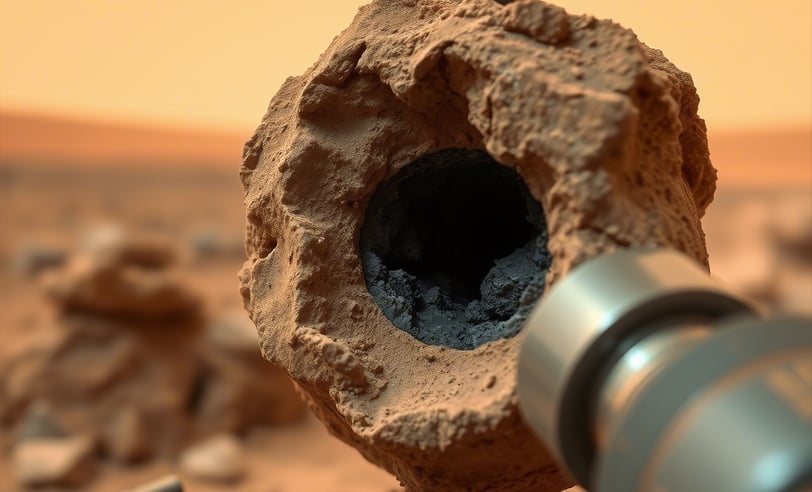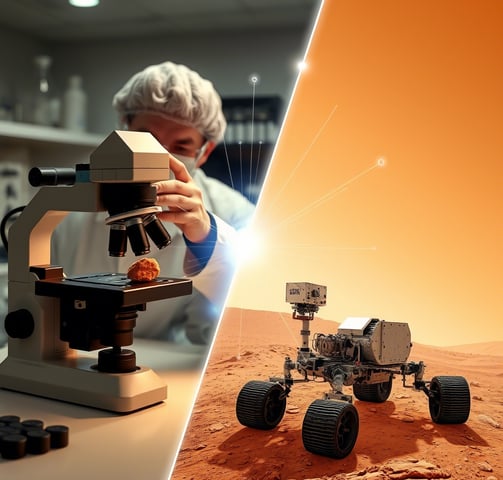Unveiling Mars' Ancient Secrets: NASA's Curiosity Rover Solves the Mystery of Missing Carbon.
Hey there, other people that love space! Have you ever gazed up into the night sky and seen that crimson glow? Did you ever think about Mars? For hundreds of years, the Red Planet has sparked our imaginations, leading to stories of alien civilizations and daring space adventures. But what if I told you that new discoveries that have changed the game are showing us a picture that is much more amazing than any science fiction book? What if Mars, which looks like a dry, empty place, was once a lively, liquid world full of life? This discovery would change a lot of things, not just what we know about Mars, but also the question of whether there is life outside of Earth. In this in-depth examination, we'll speak about the extraordinary scientific route that led to these findings, separate fact from fiction, and think about what all of this means for humanity's place in the cosmos. Get ready for an adventure of discovery between planets!
AMAZINGSCIENCEEXTRATERRESTRIAL LIFEPLANETS
Bringing Blessing
7/8/202511 min read


The Curious Case of Missing Carbon


The Elusive Martian Life: What the Discoveries Don't Mean (Yet)
Sources Consulted
NASA. (2025, April 17). NASA's Curiosity Rover May Have Solved Mars' Missing Carbonate Mystery. https://www.nasa.gov/centers-and-facilities/ames/nasas-curiosity-rover-may-have-solved-mars-missing-carbonate-mystery/
Science. (2025, April 17). Carbonates identified by the Curiosity rover indicate a.... https://www.science.org/doi/10.1126/science.ado9966
Phys.org. (2025, April 17). Curiosity rover finds large carbon deposits on Mars. https://phys.org/news/2025-04-curiosity-rover-large-carbon-deposits.html
Texas State University. (2025, April 29). Researchers find evidence of the carbon cycle on ancient Mars. https://news.txst.edu/research-and-innovation/2025/txst-researchers-find-evidence-of-carbon-cycle-on-ancient-mars.html
NASA. (2022, January 17). NASA's Curiosity Rover Measures Intriguing Carbon Signature on Mars. https://www.nasa.gov/solar-system/nasas-curiosity-rover-measures-intriguing-carbon-signature-on-mars/
LiveScience. (2025, April 19). Curiosity rover finds largest carbon chains on Mars from 3.7 billion-year-old rock. https://www.livescience.com/space/mars/curiosity-rover-finds-largest-carbon-chains-on-mars-from-3-7-billion-year-old-rock
NASA. Opportunity Rover. https://mars.nasa.gov/mer/mission/rover/
NASA. (2022, February 2). NASA-Funded Study Extends Period When Mars Could Have Supported Life. https://www.nasa.gov/solar-system/nasa-funded-study-extends-period-when-mars-could-have-supported-life/
University of Oxford. (2021, November 18). Life on Mars search could be misled by false fossils. https://www.ox.ac.uk/news/2021-11-18-life-mars-search-could-be-misled-false-fossils
CNN. (2025, March 29). Curiosity rover detects large organic molecules on Mars that.... https://www.cnn.com/2025/03/29/science/mars-curiosity-large-organic-molecules
NASA. Sample Analysis at Mars (SAM). https://mars.nasa.gov/msl/spacecraft/instruments/sam/
NASA. Mars Sample Return. https://mars.nasa.gov/msr/
Scientific American. (2017, October 11). Did Mars Once Harbor Deep-Sea Cradles of Life?. https://www.scientificamerican.com/article/did-mars-once-harbor-deep-sea-cradles-of-life/
The Week. (2021, March 19). Mars myths: 6 Red Planet hoaxes, exposed. https://theweek.com/952291/mars-exploring-the-red-planet/2
Reuters. (2008, May 14). Vatican scientist says belief in God and aliens is OK. (Archived link: https://web.archive.org/web/20090220083400/http://uk.reuters.com/article/scienceNews/idUKL148102920080514)
NASA. Mars Sample Return. https://mars.nasa.gov/msr/
CNN. (2020, December 2). Potential life on ancient Mars likely lived below the surface, study says. https://www.cnn.com/2020/12/02/world/mars-subsurface-habitability-scn-trnd
Harvard SEAS. (2019, July 15). A material way to make Mars habitable.
This article was written based on extensive research from open sources on the internet, including news portals, social media, and discussion forums. The information presented here reflects the current state of the debate. The veracity of the claims and the interpretation of the facts are the responsibility of the original sources.
Before you start picturing small green men or complicated Martian ecosystems, it's important to make clear what these amazing discoveries don't signify, at least not yet. Finding organic compounds and confirming that circumstances on Mars were once suitable for life do not, by themselves, prove that life existed there in the past. You might locate a kitchen with running water and food, but that doesn't indicate someone is cooking. It signifies that the weather is good for cooking.
When scientists talk about the chance of life, they are very careful with their words. John Grotzinger, who used to be the project scientist for the Curiosity expedition, famously said, "These results show that early Mars was habitable, but this does not mean that Mars was inhabited." This difference is quite important. While it's great that organic molecules are there, they can also be explained by things that aren't living, like geological action or meteorites bringing them.
The Problem of False Positives: Imitating Life
There are many problems with the hunt for life outside of Earth, and one of the largest is the chance of getting "false positives." Researchers have said that chemical processes can make fossil-like specimens that might easily be mistaken for real biological fossils. This is why every possible biosignature, or sign of life in the past or present, is carefully looked at and needs more than one piece of evidence before it can be declared conclusive.
For instance, the Curiosity and Perseverance rovers have found different types of organic carbon molecules in different parts of Mars, which suggests that organic carbon is abundant on the planet. However, scientists are still trying to figure out where these molecules came from. Are these the remains of life that used to exist on Mars, or are they just the consequence of natural processes? This is where the ongoing research, including sample return trips, becomes very important.
Experiments and the Scientific Method: How We Verify Martian Secrets
NASA's Mars rovers are like moving labs that have instruments that can investigate the environment on Mars. For instance, Curiosity's SAM tool can heat samples to very high temperatures, which makes gases escape. After that, scientists look at the gases to see what chemicals they are made of and how many isotopes they have. We may use these isotopic ratios to find out where carbon came from, such as whether it came from living organisms or the Earth.
The Role of Rovers: Labs on the Ground
NASA's Mars rovers are like moving labs, carrying a set of tools that can study the Martian environment. For example, the SAM instrument on Curiosity can heat samples to very high temperatures, which causes gases to escape. These gases are then studied to find out what chemicals they are made of and how many isotopes they have. These isotopic ratios can help us figure out where carbon came from, whether it was from living things or the Earth.
The Perseverance rover, which is the newest member of NASA's fleet of Mars rovers, goes even further. Not only can it study samples on Mars, but it can also collect them and store them for a future Mars Sample Return mission. The goal of this mission, which is a cooperative effort between NASA and the European Space Agency (ESA), is to bring back samples of Martian rock and soil so that scientists can study them more closely on Earth. Think about how amazing it would be if scientists on Earth could use the most powerful tools to directly look at Martian material for clear signs of life!
Experiments and Analogues on Earth
Scientists do a lot of research on Earth using Martian analogs, which are habitats that are similar to those on Mars. This involves looking at extremophiles, which are organisms that do well in really harsh settings on Earth, such as deep-sea hydrothermal vents or lakes with a lot of acid. Learning about how life survives in such extreme environments on Earth will help us figure out where and how life may have existed on Mars a long time ago.
Also, scientists do experiments in the lab to mimic Martian conditions to test ideas about how minerals and organic molecules develop. Researchers may, for instance, test different molecules to simulated Martian radiation or weather to see how they react and what they make. This helps tell the difference between compounds that come from living things and those that don't.
The finding of a carbon cycle on ancient Mars fits along with another long-held scientific belief: that Mars used to be a considerably wetter place. For a long time, pictures from space and geological features on the surface of Mars have suggested that there was a lot of liquid water there in the past. There are apparent signs of old riverbeds, huge lakebeds, and even things that make it look like there used to be an ocean in the north.
A world with rivers that flow, lakes that are calm, and maybe even a huge ocean. It's very different from the Mars we know today, which is cold, dry, and dusty. There is a lot of proof that this watery past is real, not just an idea. For example, hydrated minerals, which form when water is present, are found all across the surface of Mars. The Opportunity rover, another NASA rover that explored Mars, uncovered strong evidence of past water habitats, including minerals like hematite.
("blueberries") that grow in water.
Newer results continue to support this view. Scientists have uncovered signs of liquid water underneath the surface of Mars, which means that there may still be secret reservoirs of water below the planet's cold surface. This is especially interesting because if life ever developed on Mars, the subsurface would be a safe place to live away from the harsh radiation and severe temperatures that are common on the surface.
How long might people live on Mars? A Changing Timeline
One of the most remarkable aspects about this study is how our ideas about how long Mars might have been able to host life have shifted throughout time. At first, it was thought that there was a short time limit, but new evidence kept pushing that back. Researchers believe that Mars may have possessed liquid water and even tiny living things for hundreds of millions of years, even until the late Hesperian epoch. This means that the conditions that were good for life continued for a long time, which gave life a lot of time to start and change.


The Unfolding Story of Mars: A Personal Reflection
What's Next for Mars? The Future of Exploration


The Curiosity rover and other missions have not only taught us a lot about Mars' past, but they have also had a huge impact on how we will explore Mars in the future. The search for biosignatures and figuring out the planet's potential for past and possibly present life is becoming more and more important.
Finding biosignatures is a top priority.
The main goal of future missions is to locate clear proof of life that existed in the past. As was said before, the Mars Sample Return mission is a great example. Scientists will be able to employ very sensitive tools that can't be delivered to Mars when they bring samples back to Earth. This will make it more likely that they will find small biosignatures.
The Martian subsurface is another important topic of study. Because the surface of Mars is so full of radiation, many scientists think that if life ever thrived there, it probably moved to safer places beneath. Future expeditions might include drilling further into the crust of Mars or looking for lava tubes and caverns, which could have living microbes in them.
Terraforming and colonizing other planets: are they science fiction or the future?
Science fiction has long been interested in the idea of "terraforming" Mars so that people can live there. Most scientists agree that large-scale terraforming is not possible with the technology we have now and would take thousands of years. However, some researchers are looking into smaller-scale methods. For instance, there are plans to employ materials like silica aerogel to make small areas on the surface of Mars that can support life, similar to how Earth's greenhouse effect works.
It will be decades before humans can live on Mars, but the scientific discoveries that are constantly being made are very important for making that happen. To make long-lasting human settlements, we need to know about the planet's resources, possible dangers, and how it used to be able to support life. The ultimate goal is not just to fly to Mars, but also to maybe set up a permanent human presence there, which would be a big step for humanity.
Scientists have been trying to figure out a strange puzzle about Mars for years: if ancient Mars had liquid water and a thicker atmosphere full of carbon dioxide, which are both necessary for life as we know it, where did all that carbon go? The carbon cycle is a complicated system that constantly recycles carbon on Earth. It is very important for controlling the climate on our planet and for providing the building blocks for all living things. But on Mars, it was hard to find proof of a strong carbon cycle, which left a big gap in our knowledge of its past.
The brave Curiosity rover from NASA is here. This six-wheeled robotic geologist has been carefully investigating the Martian surface since it landed in Gale Crater in 2012. It has been digging into rocks and studying their makeup. Scientists who have been looking at data from Curiosity have now uncovered the smoking gun: the presence of siderite, an iron carbonate mineral, in the rocky strata of Mount Sharp in Gale Crater. This is a genuinely groundbreaking discovery.
Siderite isn't just any mineral; it's a game-changer. It needs certain circumstances to form, such as having liquid water and a lot of carbon dioxide in the air. A report published in the well-known magazine Science in April 2025 talks about the discovery. It is the first direct proof of a carbon cycle on Mars a long time ago. What a thought! Mars kept its secret buried deep in its rusty soil for billions of years, waiting for our robots to find it.
Who, When, and How: Figuring Out the Discovery
So, who discovered this incredible phenomenon, and how did they accomplish it? A group of experts from all across the world worked hard for years to study data from Curiosity's powerful instruments. Scientists from the University of Chicago, Texas State University, and the Planetary Science Institute (PSI) have been at the forefront of this field of study.
Curiosity's capacity to drill into Martian rocks and look at their chemical and isotopic makeup is what made this discovery possible. The rover's Sample Analysis at Mars (SAM) instrument suite, which is like a little chemistry lab on wheels, was very important. SAM can find and measure different compounds, such as carbonates, by heating rock samples. Finding siderite, in particular, was the proof that a carbon cycle happened in the past.
The most recent research on siderite was published in April 2025. However, it's important to remember that Curiosity has been finding organic carbon molecules on Mars for some time now. Earlier findings in 2022 and 2025 identified complicated organic molecules on Mars, some of which had chains of up to twelve carbon atoms. This is more evidence that Mars may have had life in the past. These organic molecules are the basic parts of life, and the fact that they are on Mars, even without proof that they came from living things, is quite fascinating.
As a blogger, I've had the chance to see some amazing scientific advancements, but the narrative of Mars is one of the most interesting. It's a story that makes us want to know more: Are we by ourselves? Where did we come from? What will happen in the future?
It's easy to get lost in the technical language and complicated scientific explanations when you read about these discoveries. But take a moment to stand back and see how brave what we're doing is. We're sending robots millions of miles into space, telling them where to land on another planet, and utilizing them to find out things that have been concealed for billions of years. It shows how smart, determined, and curious we humans are.
And what does this signify for us on Earth? Not only can studying Mars help us understand more about our own world, it also helps us learn more about Mars. By studying how Mars became uninhabitable, we learn a lot about how the climates of planets change and how the delicate balance that keeps life on Earth going works. It's a stark reminder of how vital and important our home planet is.
When you see that red dot in the night sky, think about the great journey of discovery that is happening right now. Think about the Curiosity rover, which is working hard on a distant planet to find out things that could revolutionize how we see our place in the cosmos. And don't forget that the hunt for knowledge is a never-ending journey full of wonder, mystery, and the promise of even more fantastic things to come. What else does Mars still have to hide? Only time and additional exploration will tell.
A Watery Past: Unraveling Mars' Ancient Oceans and Rivers




You might also like:
Contact Us


Want to know more? Our "Question and Answer" area is here to answer your questions and start important conversations.
Partners Products
Qualifies for free shipping offer.
Young Scholar Study Bible NKJV (Leather-soft Pink)
U$ 59.99
Amazing Illustrated Bible for Kids
U$ 59.99
Platinum Remnant Study Bible KJV (Genuine Top-grain Leather Gray/White) King James Version
U$ 129.99
Qualifies for free shipping offer.
Qualifies for free shipping offer.
Faith
Exploring the biblical truth and knowledge.
COMMUNITY
+55 95 98117-7630
© 2024 - 2025. All rights reserved.
Hamillton Rice Street 114 - Boa Vista- RR - BR






